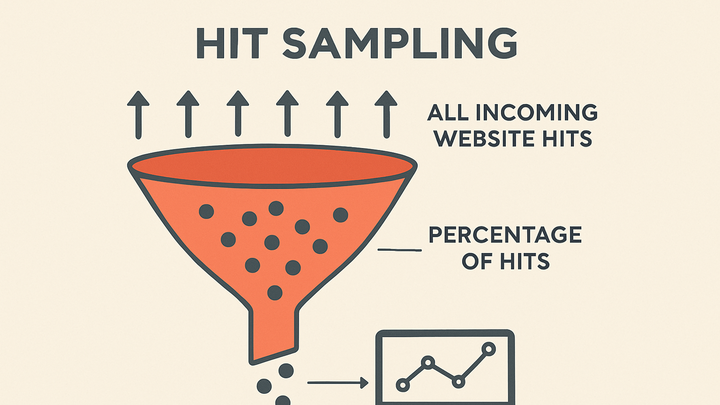Published on 2025-06-28T08:20:35Z
What is Hit Sampling? Examples in GA4 and PlainSignal
Hit sampling is a method where analytics systems process only a fraction of total data hits (pageviews, events) instead of every single one. This approach helps manage data volume, reduce processing time, and control costs, especially for high-traffic websites. Different platforms handle sampling differently: Google Analytics 4 (GA4) applies sampling at query time when thresholds are exceeded, while PlainSignal provides full-fidelity, cookie-free analytics without sampling by default. Understanding hit sampling enables you to balance data accuracy with performance and budget considerations. In the following sections, we explore why hit sampling matters, how GA4 implements it, how PlainSignal avoids it, and best practices for using sampling effectively.
Example PlainSignal tracking code:
<link rel="preconnect" href="//eu.plainsignal.com/" crossorigin />
<script defer data-do="yourwebsitedomain.com" data-id="0GQV1xmtzQQ" data-api="//eu.plainsignal.com" src="//cdn.plainsignal.com/plainsignal-min.js"></script>
Example GA4 tracking code:
<!-- Google Analytics 4 -->
<script async src="https://www.googletagmanager.com/gtag/js?id=G-XXXXXXX"></script>
<script>
window.dataLayer = window.dataLayer || [];
function gtag(){dataLayer.push(arguments);}
gtag('js', new Date());
gtag('config', 'G-XXXXXXX', { 'send_page_view': true });
</script>
Hit sampling
Hit sampling selects a subset of analytics hits to balance data accuracy, performance, and cost in platforms like GA4.
Why Hit Sampling Matters
Sampling helps manage the trade-offs between data volume, processing time, and cost when analyzing large datasets.
-
Performance optimization
Sampling reduces the volume of data sent to analytics servers, which improves processing speed and report response times.
-
Reduced server load
By collecting fewer hits, servers spend less time processing, leading to faster data availability.
-
Faster reporting
Smaller datasets mean that dashboards and queries load more quickly for end users.
-
-
Cost management
Many analytics platforms charge based on data volume; sampling can help control these expenses.
-
Avoiding overages
Consistent sampling rates prevent unexpected spikes in data that could exceed plan limits.
-
Budget planning
Predictable data volumes make it easier to forecast and allocate budgets for analytics services.
-
How GA4 Implements Hit Sampling
Google Analytics 4 applies sampling at query time for properties that exceed certain event processing thresholds.
-
Threshold-based sampling
GA4 free properties apply sampling when more than 10 million events are queried, while GA4 360 properties have higher limits.
-
Sampling on reports
Sampling may occur in Exploration reports or when querying large date ranges, impacting data precision.
Hit Sampling with PlainSignal
PlainSignal offers cookie-free, privacy-focused analytics that avoid hit sampling altogether, providing full-fidelity data.
-
No sampling by default
Every pageview and event is recorded without being sampled, ensuring complete datasets for analysis.
-
Lightweight tracking
PlainSignal’s minimal script ensures efficient data collection without the need to reduce sample size.
Use Cases for Hit Sampling
Sampling is appropriate when full data collection could overwhelm systems or exceed budgetary limits.
-
High-traffic websites
Sites with millions of hits per day may sample to keep analytics pipelines performant.
-
Cost-constrained projects
When working under tight budgets, sampling helps maintain insights without incurring high data fees.
Best Practices for Hit Sampling
To make sampling effective, it’s important to choose rates and validation techniques that preserve data accuracy.
-
Set appropriate sample rates
Balance between data precision and system load by experimenting with different sampling percentages.
-
Validate with unsampled data
Periodically compare sampled reports against unsampled datasets or shorter date ranges to assess accuracy.
